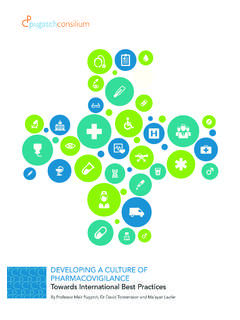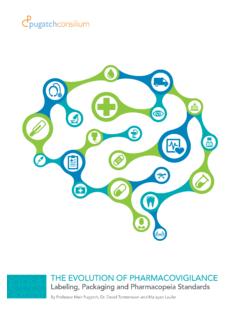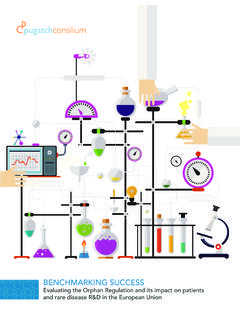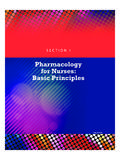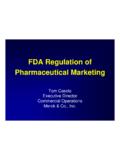Transcription of Risks and negative implications of compulsoRy licensing ...
1 Risks and negative implications of compulsoRy licensing for Pharmaceuticals in Russia: Myths Versus Facts 1 Myth: The use of compulsoRy licensing in Russia would enable greater and more rapid access to innovative medicines in areas of 3. Myth: compulsoRy licensing would be an effective method of achieving favorable negotiations on patented medicines that unmet need. currently have limited availability in Russia. fact : Manufacturing a generic version of a fact : The act of issuing a compulsoRy license drug under a compulsoRy license may not will create a hostile negotiating environment necessarily result in a more affordable price for the Russian biopharmaceutical or a dependable supply of the drug in Russia. It is likely to reduce the willingness of all parties to It could also limit incentives for conducting collaborate in future negotiations and investment domestic clinical trials and manufacturing of decisions.
2 New, specialty drugs some of the fastest ways of accessing these In Russia, it could introduce challenges to achieving coverage for patented medicines on the EDL and Yet clinical trial activity in Russia is already falling: specific reimbursement schemes for specialty there were fewer trials between 2012 and Local manufacturing of innovative drugs, though increasing somewhat, is relatively stifled as it stands the volume of all locally produced drugs, 4 Myth: Intellectual property protection is the reason why innovative drugs are not accessible in Russia. innovative and generic, sold in pharmacies dropped fact : IP protections are not barriers to access. by 7% between Q2-2013 and On the contrary, without IP protections The use of compulsoRy licensing in Russia most innovative products, and in turn the Risks further hampering R&D and local generic products that are produced after manufacturing there.
3 Those protections lapse, would not exist. Rather, many factors lead to higher cost and inadequate supply of specialty medicines in 2 Myth: Russia will be able to secure lower drug prices as a result of compulsoRy licensing . Peripheral regions in Russia lack human and fact : A generic drug manufactured under a technological resources to effectively supply and compulsoRy license will not necessarily be administer drugs treating cancer and rare much more affordable than the original Taxes on medicines, low levels of health spending Average prices of most off-patent drugs (71%) are and gaps in reimbursement are additional higher in Russia than the average prices of the same contributing factors. 60% of prescription drugs in drugs in many other countries, including among the Russia are paid for BRICs, the EU and the CIS compulsoRy licensing does not address these Prices of generic drugs are even at times higher elements.
4 Than the original In this context, compulsoRy licensing may not lead to the prices anticipated for needed medicines in Russia. Small gains in price may be outweighed by larger, long-term impacts on the economy and the availability of innovative medicines. 1. Risks and negative implications of compulsoRy licensing for Pharmaceuticals in Russia: Myths Versus Facts 5 7. Myth: compulsoRy licensing would involve no Myth: compulsoRy licensing is one of the only Risks for Russian patients or the health system. policy instruments capable of enabling access to needed high-cost medicines. fact : The production of advanced medicines by Russian manufacturers under a compulsoRy fact : Several alternative and voluntary license may lead to serious Risks for Russian channels may be used for securing access to patients. needed medicines for Russian patients. Too many Russian manufacturers lack capacity to Short-term solutions may include enhancing ensure that drugs produced under a compulsoRy coverage schemes for specialty drugs, such as license meet international safety and quality the proposed scheme for orphan drugs currently considered by the Russian parliament,19 and spreading cost across different parties and Only around 30% of Russian manufacturers currently coverage comply with standards of Good Manufacturing Practice (GMP)
5 And are not fully required to do so Capacity building in R&D and manufacture of until innovative drugs in Russia is a fundamental route for providing long-term access to these Producing substandard medicines under a compulsoRy license could lead to adverse drug It will also drive improvements to infrastructure and reactions and faster than normal drug health care delivery across Russia, likewise crucial for ensuring effective access. 6 Myth: compulsoRy licensing would benefit Existing efforts toward this end include new Russia's pharmaceutical industry. biomedical research clusters and substantial R&D. tax fact : The benefits of compulsoRy licensing to Russian companies are limited at Moreover, compulsoRy licensing reduces incentives for the foreign investment and technology transfer needed by Russia to build an innovative industry and meet its Pharma 2020 Imported products continue to represent the majority of the Russian Imported medicines represent around 26% of the market (in terms of value), while locally produced medicines represent around 74%.
6 18. The use of compulsoRy licensing in Russia Risks further stalling the realization of its industrial and economic goals. 2. Risks and negative implications of compulsoRy licensing for Pharmaceuticals in Russia: Myths Versus Facts Notes 1 Countries with a robust level of pharmaceutical IP protection, such as the and Hudson Institute, May 2013, ; Nunn, A., Massard da Fonseca, E., Bastos, F. & Gruskin, Singapore, tend to host a higher number of clinical trials, while countries with a S. (2009), AIDS Treatment in Brazil: Impacts and Challenges , Health Affairs, , relatively weak level of IP protection, such as India and Thailand, have a very low N , ). number of clinical trials. (Pugatch, M. & Chu, R. (2011), The strength of pharmaceutical 13 , Russian medicine translate into global standards in two years , 2/17/2014, IPRs vis- -vis foreign direct investment in clinical research: Preliminary findings , Journal (Translated); Deloitte, Trends and practical aspects of of Commercial Biotechnology, , , ).
7 In relation to manufacturing development of the Russian pharmaceutical market 2013, , 12. and in the case of India, a 2013 survey of top locations worldwide to invest in advanced 14 For instance, in the case of a copy of the anti-retroviral GPO produced in Thailand, an biopharmaceutical manufacturing facilities indicates that India's attractiveness for extremely high rate of drug resistance was found in patients treated with it (roughly advanced manufacturing has plummeted since it issued the compulsoRy license on 40%-60%) and they were required earlier than anticipated to switch to a stronger Nexavar in 2012. Between 2012 and 2013, the percentage of respondents who said treatment. (Bate, R. (2007), Thai-ing Pharma Down , Wall Street Journal Asia, 2/9/2007;. the likelihood of investing in India dropped by 50%. (Langer, E. Biopharmaceutical Lybecker, K.))
8 & Fowler, E. (2009), compulsoRy licensing in Canada and Thailand: Outsourcing Continues to Expand , pharmaceutical Outsourcing, 1/28/2014, www. Comparing Regimes to Ensure Legitimate Use of the WTO Rules , Journal of Law and Medical Ethics, , , ). Continues-to-Expand/). 15 Local manufacture of compulsoRy licensed medicines may provide domestic companies 2 The Pharma Letter, Number of clinical trials in Russia declined in 2013 , 4/23/2014, with a competitive advantage in the supply of generic versions of the drug in the Russian market, however not necessarily. Moreover, domestic companies must bear 3 Economics and Life (Translated), Nine of the ten most important drugs in the country liability and costs if they produce substandard medicines under the license. have to be Russian , 5/23/2014, 16 compulsoRy licensing and an overall weak intellectual property environment have 4 For example, according to local sources the expected price of the generic version of negative implications for countries' ability to attract investment and technology sorafenib, produced in India under a compulsoRy license in 2012, would still not be transfer.
9 For example, coinciding with India's compulsoRy license in 2012, the affordable to most people there. (Health India, Despite compulsoRy licensing , generic Indian government itself has identified a drop in the level of FDI in the drugs and cancer drug too costly for the poor, 4/23/2013, pharmaceuticals sector of 30-40% compared to before the compulsoRy license conditions/despite- compulsoRy - licensing - generic-cancer-drug-too-costly-for-the- was issued. (Department of Industrial Policy & Promotion (DIPP), fact Sheet on poor/) Foreign Direct Investment, 2000-2014 , , 5 Russian Federal Antimonopoly Service (2013), Evaluation on the availability of drugs FDI_Statistics/2014 ; Shapiro, R. & Mathur, A. (2014), How based on the analysis of consumer prices and pricing of medicines in the Russian India Can Attract More Foreign Direct Investment, Create Jobs, and Increase GDP: Federation and in comparable markets (Translated), The Benefits of Respecting the Intellectual Property Rights of Foreign pharmaceutical ; , FAS Russia: Drug prices Producers, Sonecon, Jan.)
10 2014, should be fair , ). spravedlivymi-3508 17 Economics and Life (Translated), Nine of the ten . 6 , Elena Maksimkina: About the problems of drug insurance and 18 Ibid.. counterfeit products in Russia , 1/31/2014, 19 Pharma and Healthcare Insight (2014), Industry Trend Analysis Draft Bill Highlights . view/elena-maksimkin-about-the-problems- of-drug-insurance-and-counterfeit- 20 See, for instance: Yadav, P. (2010), Differential Pricing for Pharmaceuticals, UK. products-in-russia- Department for International Development, August 2010; and Ferrario, A. & Kanavos, 7 compulsoRy licensing directly undercuts the exclusivity rights of the patent holder P. (2013), Managed entry agreements for pharmaceuticals: The European experience, without his consent, generating suspicion and reduced accommodation in price and Prepared for European Commission, DG Enterprise and Industry supply negotiations throughout the market.
